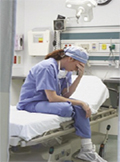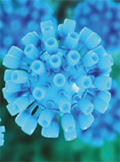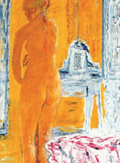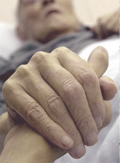The eLitMed.hu medical portal uses computer cookies for convenient operation. Detailed information can be found in the Cookie-policy.
Lege Artis Medicinae - 2018;28(06-07)
Content
[Mobbing and bullying among physicians - when colleagues become enemies]
[Workplace mistreatment, mobbing, bully-ing, or psychoterror has become a prioritised field of research in social sciences in the past two-three decades. Mobbing means more than a simple conflict situation between two individuals; it is a complex problem that could and should be investigated in various individual and organisational contexts. In spite of its large-scale theoretical and empirical research, the phenomenon still does not have a uniform definition; it is most commonly de-scribed via its social manifestations. Although the interpersonal constellation of mobbing is diverse, its trigger factors, stages and participants show similar patterns. The description and the evaluation of consequences is also uniform in the literature: workplace mobbing is accompanied by considerable health impairment, and it has severe psychosomatic and mental health effects on both the targeted individuals and the whole community. The latter group has to deal with poor performance, impaired morale and dissatisfaction. All these factors add up and lead to significant financial damage as well. The prevalence of mobbing is especially high in health care. Hierarchy, continuous overload, as well as emotional and physical stress all favour the development of mobbing. In turn, the professional-social culture of medicine that is based on traditions contributes to its acceptance, understatement and denial. The first time medical students have to face psychoterror is typically during their university years. The positive aspects of socialisation and finding their vocation cannot always compensate for the negative experiences. The model role of physicians, their behaviour towards colleagues and students can be protective, but it can also trigger further mobbing. Prevention is essential both at the organisational and individual level, and it requires complex measures whose effect will only be felt in the long term. ]
[Depression, anxiety and suicidal behavior. Recognition and care]
[Depression and anxiety disorders are major problems both in psychiatric and in general practice because of their frequency and recurring character. Owing to their common complications (suicide, suicide attempts, secondary alcoholism / drug disease, increased cardiovascular and cerebrovascular morbidity and mortality, loss of work, social isolation, etc.) they are the cause of significant individual, family and social burdens. In our paper we review the clinically revealable suicide risk and protective factors that can be observed in depression and anxiety disorders as well as the main aspects of the recognition and care of suicidal patients. With available medicines and non-pharmacological therapies, the vast majority of depressive and anxiety patients can be successfully treated and in most cases we can prevent suicidal behavior associated with these diseases. Besides psychiatrists general practitioners as well play a significant role in preventing suicidal behavior and in the recognition of suicide risk. ]
[Vision or reality? Can Hungary become hepatitis C virus free by 2030?]
[According to the WHO, there are 71 million people worldwide and 3 million people in the EU who are infected with hepatitis C virus. Most of these infections, however, remain undiagnosed and only 6-7% of them received antiviral therapy. In Hun-gary, there are an estimated 50.000 infections, out of these 20.000 are identified, the remaining 30.000 infections are outside the reach of the health care sector. Early diagnosis and therapy are of utmost importance as late diagnosis leads to se-vere liver insufficiency, hepatocellular carcinoma and multiple other extrahepatic organ impacts. In Hungary, second generation direct acting enzyme inhibitor antiviral medications with a recovery rate of almost 100% are available since 2015. Since 2018, all patients are treated with this type of therapy. Nevertheless, there are several remaining professional, organisational and health policy issues to solve. Firstly, Hungary should join the EU’s HCV elimination programme which aims to eradicate hepatitis C virus from Europe by 2030. Secondly, the frequency and efficiency of national screening should be increased. Furthermore, better information of the general population, inclusion of general practitioners and civil organisations, and introduction of the compulsory screening of high risk groups and health care professionals would be necessary. This review summarises the evolution of hepatitis C virus diagnostics and therapy over the past three decades, current best practice and the still outstanding tasks. ]
[How to diagnose idiopathic pulmonary fibrosis. Part 2]
[Idiopathic pulmonary fibrosis is a severe irreversible lung disease with a progressive course. The disease onset is hard to discover due to the unspecific signs and symptoms. It occurs mainly in elderly people. In the past decades its prevalence has increased continuously. Physical examination, restrictive pattern on lung function test with decreased diffusion capacity are characteristic features of the disease. Chest X-ray showing fibrotic pattern also points toward the diagnosis of idiopathic pulmonary fibrosis. Differential diagnosis is based on high resolution komputertomográfy. Diagnosis of IPF is based on the appearance of usual interstitial pneumonia pattern together with the lack of external risk factors and autoimmune or other diseases also known to cause this pattern seen on chest imaging. If no firm diagnosis can be built lung biopsy is required. Multidisciplinary teams from clinician, radiologist and pathologist are set in predefined centres that could provide care with novel antifibrotic drugs. These can slow disease progression and are in the frontline in the treatment of the disease. Further research is required to understand the pathomechanism and foster the discovery of further treatment options. ]
[Pharmacotherapeutic strategies on treatment of patients with high cardiovascular risk based on the 2018 European Hypertension Guidelines]
[The new joint hypertension guidelines of the European Society of Hypertension and European Society of Cardiology will simultaneously be published in August, 2018 in the J. Hypertension and Eur. Heart J. on the diagnostics, evaluation, treatment and follow up of hypertensive patients. This guidelines put emphasis on definition, and therapeutic strategies in patients with high cardiovascular risk. In this paper I summarise the cardiovascular risk factors and put emphasis on possibilities of reduction of cardiovascular risk. ]
[Feeding and eating in infancy and early childhood part II. - Breastfeeding, complementary feeding and weaning in the Large-sample of the “For Healthy Offspring” project]
[INTRODUCTION - Complementary feed-ing is the transitional period from exclusive breastfeeding to family foods, while breastfeeding is continued. It should be started, when breastmilk itself no longer meets the infant’s nutritional requirements, ideally at the age of around 6 months. SUBJECTS AND METHODS - In the Healthy Offspring project self reported questionnaires were received from 1133 parents of 0-3 year old children. Complementary feeding practices and issues of weaning were analyzed. RESULTS - In our sample complementary feeding was started at the age of 5.5±1.8 months. 6% of infants younger than 4 months and about two third of infants at the age between 4 and 6 months were started on complementary feeding. 32% of the 7-12 month old infants were continued on breastfeeding. The proportion of breastfed infants and young children in the 12-24 and 25-36 month age group was 24% and 5.5% respectively. The daily feeding frequency of breastfed infants was 6.7±1.6. The infants and young children, who were breastfed along with complementary feeding were feeding 5.6±1.5 times/day. After completed weaning the range of feeding frequency was limited to 4.9±0.9 occasions/day. 60.4% of mothers regarded their feeding style on demand, while 39.6% on set schedule. 16% of mothers reported that their child had feeding difficulties. CONCLUSIONS - Complementary feeding indicators should be part of infant feeding data collection, such as time of introduction of complementary food, feeding frequency, food consistency, energy density of food and safe preparation. Responsive feeding is part of responsive parenting and should be promoted, along with continuing breastfeeding at least till one year of age, and for as long as mother and infant wish to continue. ]
[The Galilei of Bertolt Brecht and László Németh]
[The trial of Galileo, who abjured his scientific convictions in the face of the Inquisitions was the most persistent and disturbing artistic theme of both Bertolt Brecht’s and Németh Laszlo’s writing careers. All three of them attended medical school. Galileo and Brecht never graduated whilst Németh’s medical work was subordinated to the art which became his vocation. The authors examine the genesis of Brecht’s and Németh’s dramas on Galileo, the possible effect of their medical studies or practice and their illnesses on their plays, and compare the work of the artists. This paper shows the process of their evaluating and re-evaluating their works and their struggle for further development of their artistic vision. Brecht’s and Németh's dramas, together with their formations and effects, can illuminate our understanding of the historically changing perpectivity of the scientific and artistic truth. ]
1.
Clinical Neuroscience
Is there any difference in mortality rates of atrial fibrillation detected before or after ischemic stroke?2.
Clinical Neuroscience
Factors influencing the level of stigma in Parkinson’s disease in western Turkey3.
Clinical Neuroscience
Neuropathic pain and mood disorders in earthquake survivors with peripheral nerve injuries4.
Journal of Nursing Theory and Practice
[Correlations of Sarcopenia, Frailty, Falls and Social Isolation – A Literature Review in the Light of Swedish Statistics]5.
Clinical Neuroscience
[Comparison of pain intensity measurements among patients with low-back pain]1.
Clinical Neuroscience Proceedings
[A Magyar Stroke Társaság XVIII. Kongresszusa és a Magyar Neuroszonológiai Társaság XV. Konferenciája. Absztraktfüzet]2.
3.
Journal of Nursing Theory and Practice
[A selection of the entries submitted to the literary contest "Honorable mission: the joys and challenges of our profession" ]4.
Journal of Nursing Theory and Practice
[End of Life and Palliative Care of Newborns in the Nursing Context]5.
Journal of Nursing Theory and Practice
[Aspects of Occupational Health Nursing for Incurable Patients ]











